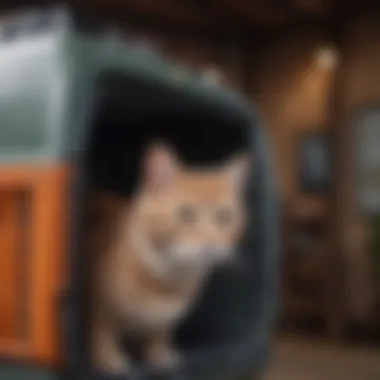Essential Features for Choosing a Quality Cat Carrier


Intro
Choosing the right cat carrier is crucial for ensuring your feline friend’s comfort and safety during travel. A good carrier minimizes stress and makes trips to the veterinarian or while on vacation much more manageable. Understanding what to look for, such as size, materials, and safety features, will help you select the best option that meets your cat's needs. The following sections will delve into various elements that underline the significance of a quality cat carrier.
Fascinating Facts About the Animal
Cats are unique animals with several fascinating characteristics that differentiate them from other pets. Understanding these traits can help owners appreciate the importance of a proper carrier design.
Unique Characteristics
Cats possess exceptional agility and senses. They can twist their bodies in mid-air, allowing them to land on their feet. Their sharp retractable claws aid in climbing and provide grip when needed. Additionally, cats demonstrate diverse temperaments; some are more adventurous while others may be timid. This behavior should influence the type of carrier chosen, as a nervous cat may require more comfort during travel.
Extraordinary Abilities
Felines communicate through varied vocalizations, body language, and even pheromones. They have keen eyesight which allows them to see in dim light. Such characteristics suggest that a carrier should provide adequate ventilation and privacy, helping cats feel secure.
Behavior and Habitat
Understanding a cat's natural behavior and habitat can guide us in the right direction when selecting a carrier.
Natural Habitats
Cats are adaptable animals that can thrive in numerous environments, from urban areas to rural fields. Each setting influences their behavior, making it essential for owners to provide practical solutions during travel.
Social Structures
Cats are generally solitary hunters but can form social bonds. When designing the carrier experience, take into account your cat's social tendencies. Some may thrive in spacious environments, while others might prefer cozy, enclosed settings for security.
Recent Scientific Discoveries
Scientific research into feline behavior continues to evolve, offering insights that inform carrier design.
Latest Research Findings
A recent study highlights how stress impacts cats during travel. Cats released pheromones that indicate anxiety when placed in confined spaces. This finding suggests that designing carriers with calming features may significantly enhance their travel experiences.
Breakthroughs in Animal Biology
Advancements in animal biology have led to better understanding the needs of domestic cats. It is now recognized that providing enrichment and comfort during travel is essential, particularly for cats that may not enjoy being transported in carriers. Good design can address these needs effectively.
Cultural Significance
Cats have held a place of importance in various cultures, and their representation in art and literature enhances our understanding of them.
Animals in Folklore
Throughout history, cats have been featured in folklore, often symbolizing mystery and independence. Understanding this cultural backdrop can deepen our appreciation for our feline companions and inform how we care for them.
Influence on Art and Literature
Cats are frequent subjects in art and literature, illustrating their irreplaceable role in human history. This cultural significance underscores the responsibility of cat owners to provide a safe and suitable environment for them, particularly during travel.
Remember, a well-chosen carrier is not just a travel necessity; it embodies your commitment to your pet's well-being. By investing in quality, you prepare your cat for a safer journey.


Preface to Cat Carriers
A cat carrier is an essential tool for any cat owner. It ensures the safe transportation of your feline friend to various destinations. The role of a good carrier extends beyond mere transportation; it is about providing security and comfort to your pet during travel. Selecting the right cat carrier involves understanding its various features and how they contribute to the overall travel experience for your cat.
Importance of a Good Carrier
A sturdy and well-designed cat carrier is more than just a container; it is a crucial element that influences your cat's wellbeing during transit. Cats can be anxious creatures, and a secure carrier can minimize their stress levels. With proper design and materials, a carrier can prevent escape attempts and provide the assurance that your pet is safe.
A good cat carrier also accommodates the physical needs of your cat. It should offer adequate space for your pet to stand, turn around, and lie down. Failing to provide enough room can lead to discomfort, which may result in anxiety or even physical harm during your journey.
It is also important for the carrier to meet airline regulations if you wish to travel by plane. Different airlines have specific requirements for pet carriers. Thus, having a well-structured carrier can simplify the travel preparation process.
Common Uses for Cat Carriers
Cat carriers have various uses in addition to travel. Some of the most common scenarios where a cat carrier is necessary include:
- Veterinary Visits: A carrier is essential for transporting your cat to the vet. It ensures your cat remains secure, especially in unfamiliar environments.
- Relocation: Moving to a new home requires a secure way to transport your cat. A good carrier provides safety during uncertain times.
- Road Trips: If you plan to take your pet on a road trip, a carrier keeps your pet restrained and secure, preventing distractions while driving.
- Emergency Situations: In emergencies, you need to act quickly. A reliable carrier allows efficient evacuation and transport of your cat.
Types of Cat Carriers
Understanding the various types of cat carriers is vital for choosing the right one for your pet. Each type has its specific attributes, advantages, and drawbacks that can significantly influence your travel experience and the overall comfort of your cat. Selecting the appropriate type will depend on your travel needs, your cat's temperament, and the intended use of the carrier.
Hard-Sided Carriers
Construction and materials
Hard-sided carriers are usually made from robust plastic. The durability of the materials contributes significantly to the safety of your pet during travel. Cats often prefer enclosed spaces, and a hard-sided carrier provides them with a secure environment. This type is particularly beneficial for longer trips, as its structure can withstand the rigors of transportation. Moreover, many hard-sided carriers can be easily assembled and disassembled, making them convenient for storage.
Advantages and disadvantages
The hard-sided carrier offers several advantages for cat owners. Its sturdy construction protects against impacts, while the easy-to-clean surfaces cater to hygiene needs. However, the weight and bulkiness of these carriers can be a disadvantage. For example, they may be challenging to handle in crowded spaces, and some cats may feel cramped inside. Understanding these pros and cons is crucial in your decision-making process.
Soft-Sided Carriers
Design features
Soft-sided carriers stand out for their lightweight and flexible design. They are often made with fabric materials, providing comfort to your cat during travel. The breathable fabric allows for ventilation while still containing your pet securely. An important design element is the padded shoulder strap, which enhances portability. The compact nature of soft-sided carriers makes them suitable for air travel since they tend to fit under the seat.
Suitability for different scenarios
Soft-sided carriers are ideal for short trips or vet visits. The design makes it easy to carry, and its storage suitability cannot be overlooked. Cats that tolerate confined spaces may prefer soft carriers due to their less restrictive feel. However, they may not offer the same level of protection during long-distance travel or in situations that require high durability.
Backpack Carriers
Convenience for outdoor adventures
Backpack carriers have gained popularity for outdoor activities. They allow pet owners to transport their cats hands-free, making hiking or walking more manageable. These carriers often include features such as mesh panels for visibility and ventilation, ensuring comfort for your cat. Added convenience allows you to enjoy more adventurous outings while providing a safe haven for your feline friend.
Weight and size considerations
When choosing a backpack carrier, weight and size are crucial factors. Many models aim to be lightweight while still being spacious enough for your cat to sit or lie down. Comfort matters, as an ill-fitting carrier may lead to discomfort during travel. For owners who enjoy frequent outings with their pets, the right backpack carrier can significantly enhance the experience for both cat and owner.
Key Features to Consider
Identifying the most important features of a cat carrier is essential for pet owners. A good carrier ensures a safe and comfortable travel experience for your cat. It can impact not only the well-being of your pet but also the ease of travel for you as an owner. Understanding these features helps in making informed decisions that cater to the unique needs of different cats.


Size Appropriateness
Measuring your cat for a suitable fit
Measuring your cat accurately is crucial to ensure the right fit in the carrier. You need to take into account the cat's length and height. This aspect contributes to your cat's overall comfort during travel. If the carrier is too small, the cat may feel cramped and distressed. On the other hand, an oversized carrier can result in excessive movement, making your cat feel insecure. A carrier that fits well provides a consistent sense of safety. Therefore, appropriate size becomes a priority for an effective carrier.
Implications of size on comfort
The size of the carrier directly influences the comfort level for your cat. A properly sized carrier allows your cat to stand, turn around, and lie down with ease, which is vital for long trips. This element is not only about physical space but also about the mental comfort of your pet. A well-fitting carrier promotes a sense of security, reducing anxiety during travel. Therefore, understanding the implications of size can significantly improve your travel experience with your cat.
Ventilation and Visibility
Importance of airflow
Airflow is a fundamental feature of a good cat carrier. Proper ventilation helps maintain a comfortable temperature and provides fresh air, which is vital for your cat's well-being during transport. A carrier with insufficient airflow can lead to overheating or increased stress, particularly in warmer weather. It becomes clear that choosing a carrier with ample ventilation slots or mesh panels promotes a healthier environment.
Design aspects for visibility
Visibility is another key factor in the design of a cat carrier. Features like mesh windows allow cats to see their surroundings, which can reduce feelings of confinement. When cats can observe outside, they may feel more at ease. This aspect is particularly beneficial for timid or nervous cats, as it helps them settle during the travel process. Good design that facilitates visibility can aid in reducing travel anxiety and promoting positive experiences for your cat.
Durability and Maintenance
Materials that withstand wear and tear
The durability of a cat carrier is determined by the materials used in its construction. High-quality plastic or heavy-duty fabric carriers generally withstand the rigors of travel, preventing damage from bites, scratches, or impacts. This quality is particularly important if you travel often with your cat. Investing in a robust carrier can reduce the need for frequent replacements, making it a beneficial long-term choice.
Ease of cleaning and upkeep
Cleaning and maintaining a cat carrier is essential for hygiene. Cat carriers should ideally be easy to clean and maintain. Carriers that have removable inner liners or are made from wipeable materials simplify this task. An easy-to-maintain carrier prevents the buildup of dirt and odors, which contributes to the overall comfort of your pet. Therefore, selecting a carrier with a focus on maintenance can lead to a better travel experience for both the owner and the cat.
Safety Features
Escape-proof mechanisms
Ensuring that a cat carrier has effective escape-proof mechanisms is vital. Strong locks and latches provide an extra layer of security. If a cat feels insecure, it may attempt to escape, which can lead to dangerous situations. A well-designed carrier with reliable mechanisms can guarantee that your cat stays secure throughout the journey. This safety feature stands as a primary concern for responsible pet owners.
Secure closures and their significance
The closures on a cat carrier play a significant role in its overall safety. Secure closures prevent accidental openings during travel. The use of durable zippers or latches ensures that your cat remains safely inside the carrier. It is important to consider the type of closure provided, as this can make a substantial difference in emergency situations. Thus, having solid closures is a non-negotiable aspect for effective cat carriers.
Practical Tips for Using a Cat Carrier
Using a cat carrier effectively requires more than just throwing your cat in and hoping for the best. It involves planning, understanding your cat's behavior, and making the journey smooth. This section offers practical tips that cater to the needs of both pets and their owners, ensuring comfort and safety during travel.
Acclimating Your Cat
Steps to introduce the carrier
Introducing the cat carrier to your feline companion should be a gradual process. This is crucial for reducing anxiety during travel. Start by placing the carrier in an area your cat frequents. Keep the door open and allow them to explore it at their own pace. You can place familiar items inside, like a favorite blanket or toy.
The key characteristic here is that this approach makes the carrier more familiar and less intimidating. It encourages your pet to regard the carrier as a safe space. This choice is beneficial, as it aims at developing comfort over fear. One unique feature of this step is the ability to observe your cat's reactions. You can gauge their comfort level and adapt the environment or the timing as needed.
Creating a positive association


Establishing good associations with the carrier is essential. After your cat explores the carrier, encourage them to go inside by using treats or their favorite toys. This positive reinforcement helps create a favorable mindset. When the carrier is perceived as a source of rewards, the cat is more likely to accept it.
This concept relies on the principle of conditioning, making it a popular choice amongst cat owners. A distinctive feature of this method is its adaptability; you can use it regardless of your cat's temperament. The advantage here is that it reduces travel anxiety, a significant concern for many cat owners.
Packing Essentials for Travel
Necessary items for comfort
Packing essentials can make a profound difference in your cat's travel experience. Items like a familiar blanket, portable water bowls, and specific food can help ease the transition. These provisions should cater to your cat’s comfort needs. A crucial characteristic of this planning is ensuring that everything fits within the carrier while still allowing space for the cat to move.
Considering these necessities is a beneficial step. When traveling, ensuring comfort translates directly to a calmer pet. The unique aspect of this practice is planning ahead, allowing for a contingency plan if travel delays occur. Recognizing your cat's needs will enhance their overall travel experience.
Managing travel stress for your cat
Managing travel stress requires careful consideration of the environment and the timing of the journey. Familiarity can help; travel when your cat is most relaxed. If your cat is skittish, minimize loud noises and sudden movements within the vehicle. One effective practice is playing calming music or using pheromone sprays to create a soothing atmosphere.
This topic is important because it highlights the impact of environment and anticipation on your cat's behavior. A key characteristic here is the focus on prevention; by managing stressors, the chances of a negative travel experience are significantly lowered. A note of caution is to avoid forcing your cat into unfamiliar situations too quickly, as this can exacerbate anxiety.
Ensuring that your cat is comfortable during travel is not just about the carrier; it involves thoughtful planning and attentiveness to their needs.
In summary, these practical tips serve as a framework for effectively using a cat carrier. Acclimatizing your pet, creating positive associations, packing essentials, and managing stress are all pivotal in enhancing your pet's travel experience. Understanding these aspects can lead to more successful trips, thus benefiting both the pet and owner.
Travel Regulations and Guidelines
Understanding the travel regulations and guidelines for cat carriers is essential for any pet owner. The rules vary between air travel and road trips, and being informed ensures a smooth experience for both you and your cat. Adhering to these guidelines not only prioritizes your animal's safety but also reduces stress during travel. Failure to meet regulations can lead to delays, additional costs, or even an inability to travel with your cat.
Air Travel Requirements
When traveling by air, each airline has its own specific regulations regarding cat carriers. It is critical to check these guidelines before booking a flight. Here are some key aspects to consider:
- Carrier Size: Airlines usually specify the maximum dimensions for carriers that fit under the seat. Measure your carrier and compare it to the airline specifications.
- Ventilation: The carrier must offer adequate ventilation. Most airlines will require venting on all sides.
- Secure Closure: Ensure that your carrier has a reliable locking mechanism to prevent accidental opening.
- Travel Health Certificate: Many airlines require a health certificate issued by a veterinarian. This certificate should confirm your cat's health status and recent vaccinations.
Traveling without the proper documentation can result in boarding denials or quarantine.
- Comfort Items: Consider placing familiar items inside the carrier to help ease anxiety, like a favorite blanket or toy. However, verify that these items are allowed per airline rules.
Road Trip Considerations
Traveling by car offers more flexibility compared to air travel, but certain guidelines still apply to ensure a safe journey.
- Frequent Breaks: Schedule stops every couple of hours to allow your cat to stretch, hydrate and relieve themselves.
- Secure the Carrier: Use seat belts or other restraint systems to secure the carrier in the car. This prevents excessive movement during driving that could cause injury.
- Temperature Control: Monitor the cabin temperature. Avoid leaving your cat in a hot car. Air conditioning and proper ventilation are essential.
- Feeding Schedule: Plan feeding times appropriately. It’s best to feed your cat a few hours before departure to prevent motion sickness.
- Emergency Kit: Pack an emergency kit including water, food, a leash, and first aid supplies in case of unforeseen circumstances.
Keep these various regulations and guidelines in mind when preparing for travel. They act as critical safeguards that protect your pet's well-being and enhance their travel experience.
Culmination
A good cat carrier is more than just a container to transport your feline friend; it plays a crucial role in ensuring their safety and comfort while on the move. This article has covered several key features that potential buyers should consider when choosing a carrier. It emphasizes the importance of size, durability, ventilation, safety features, and ease of use. Recognizing these aspects can significantly influence the experience for both the pet and the owner during travel.
Summarizing Key Points
In summary, the essential features to consider when selecting a cat carrier include:
- Size Appropriateness: Measure your cat correctly to ensure a comfortable fit;
- Ventilation and Visibility: Good airflow is vital for your cat’s comfort;
- Durability and Maintenance: Choose materials that can endure wear and tear;
- Safety Features: Look for secure closures and escape-proof designs.
Understanding these elements helps pet owners select carriers that are both functional and suited to their cat's individual needs.
Making an Informed Decision
Making a well-informed decision when choosing a cat carrier involves careful consideration of your cat's specific requirements and travel conditions. Assess factors like the length of travel, the temperament of your cat, and the type of carrier that best suits your lifestyle.
Take the time to research different brands and materials. Reading customer reviews can offer insights into durability and usability. Further, engaging with fellow cat owners on platforms like Reddit or Facebook can provide valuable recommendations. The right carrier will ensure your travels are safe, efficient, and enjoyable for both you and your cat.







